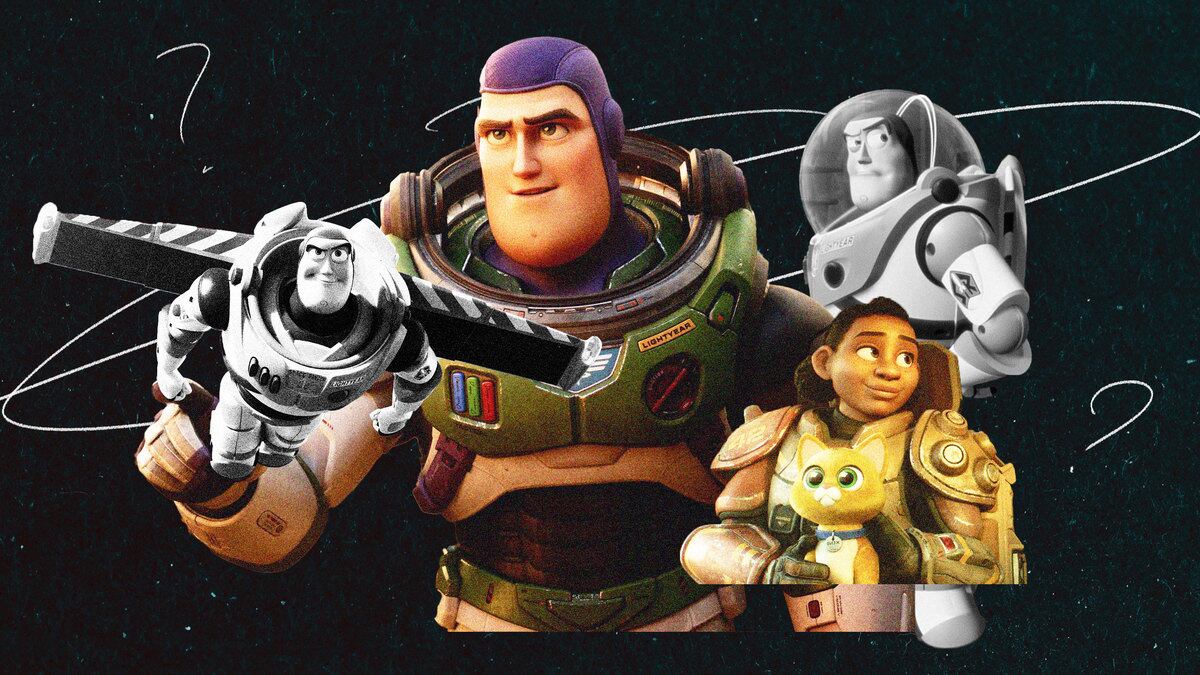Ever since it was announced, Disney/Pixar’s Lightyear has been confusing people. What initially was expected to be another perfunctory prequel for a beloved character was quickly revealed to be something much more convoluted. Baffling, even. As in it will take audiences infinity to beyond logic.
Chris Evans, assuming the role of Buzz Lightyear from Toy Story’s Tim Allen, tweeted a clarification of what kind of origin story this would be, spawning much head scratching and even more memes.
Now that the film arrives, it pains me to say that this human/toy mishegoss is only more complicated by the film itself. And that’s because Lightyear opens with a cryptic message that not only overshadows the rest of the movie that follows, but rips a hole into the Toy Story time-space continuum [Warning: HEAVY SPOILERS for Lightyear incoming]:
“In 1995, Andy was given a toy. The toy was from his favorite movie. This is that movie.”
That’s right, Lightyear isn’t just an origin story; we’re told that the movie we are about to watch is a movie that a character within Toy Story has actually seen.
In her The Daily Beast review, Laura Bradley articulated the gravest sins Lightyear commits succinctly: “What’s most galling about Lightyear is that it’s not really a bad movie—it’s a predictably conceived, utterly pointless one that will none the less probably bring in $1 billion at the worldwide box office, as did the last two Toy Story films.”
While this film works for family audiences today partly because Buzz Lightyear is a pre-established character, it’s dizzying to imagine the reality of it existing as an original entity within Toy Story. In Andy’s world Lightyear seems strangely adult-skewing, like Disney made Total Recall for children. But even more, it creates a lot of inconsistencies with what we have already seen of Andy’s reality. As Lightyear stumbles to make a compelling story on its own, it’s difficult to not get caught up in the incongruities.
Here are some lingering unresolved questions about how Lightyear functions within the Toy Story universe…

Buzz Lightyear and Sox in "Lightyear"
Courtesy of DisneyDoes the Lightyear movie that Andy fell in love with exist within the Disney universe?
After the title card that states “this is that film” that Andy saw, we still get another title card within Lightyear that says it is a Disney film. This would mean that the Andy’s-world Lightyear is a Disney product, forcing us to contemplate the Toy Story universe as an alternate timeline of sorts. It only gets more complicated from here…
What about the gay character?
Introduced alongside Pine’s Buzz is his partner and best friend Alisha Hawthorne, voiced by Uzo Aduba. When Buzz returns from his first failed light speed mission, we learn that not only is Hawthorne an open lesbian but she has a new girlfriend for Buzz to meet. As Buzz attempts more light speed missions, resulting in a series of time loops where time passes slower for Buzz in space than the rest of the space-planet-bound Star Command team, we see that Hawthorne marries her girlfriend Keiko and they start a family.
A scene in which Alisha and Keiko greet each other with a kiss has spawned predictable controversy. First there were reports that the kiss was edited out, then that it was reinstated. Countries including Saudi Arabia and the United Arab Emirates have banned the film, reportedly over the kiss.
Doesn’t that read like Disney trying to rewrite their own shaky (and only very recent) history of supporting gay characters?
It totally does! Andy, therefore, is raised with a more inclusive set of films than the real world kids his age who grew up on Toy Story. Even if Lightyear’s queer representation is minor to the plot (though still featuring two non-white women kissing and starting a loving and happy family together), this is far less inconsequential than non-starter moments—such as the reimagining of Lefou in the live action Beauty and the Beast and a blink-and-you-miss-it kiss between extras in the final Star Wars film—that Disney has congratulated itself for in the past.
Even if it’s not intentional, positioning Lightyear in the Toy Story timeline and as a Disney film means that Disney gets to rewrite itself a past where it was always unabashedly including openly queer characters in their films rather than continuing to begrudgingly include them and only on the sidelines. It’s more maddening the more you think about it.
What the hell is going on with Zurg?
Plain and simple, Zurg now makes no sense as a villain. This is also an example of what was established in the Toy Story universe (a kind of campy, kind of crunchy monolithically evil robot villain) being far more fun than with what is fleshed out in Lightyear.
Within this film, his existence is too head-spinning to enjoy: In a time loop caused by one of Buzz’s failed light speed missions, Buzz battles with the new Star Command administration, becoming Zurg so that he can continue his own objectives. In Lightyear, Zurg is Buzz. If the character is supposed to be Buzz’s arch nemesis, as we’ve seen him in the Toy Story films, this seems like a significant reveal to be missing from those movies’ representation of Zurg.
In Toy Story 2, Zurg even serves an “I am your father” reference to Buzz. To make things even more convoluted in Lightyear, Buzz first thinks the de-suited Zurg is his father, before being told he is looking at an older version (and from another time loop? Let’s not even touch how this film explains time loops or multiverses!) of himself. And this is supposed to be a movie made for children in the 1990s!

Buzz Lightyear fights Zurg in "Lightyear"
Courtesy of DisneyDoes this Buzz act much like the toy Buzz?
This is also pretty muddled, from the catchphrases to the gadgetry of the toy. The way Buzz defined himself as a toy all make an appearance, but never exactly in the same way. Here “to infinity and beyond” is more of a friend mantra between Buzz and his Alisha than the heroic, bravura proclamation as Tim Allen’s Buzz deployed it. The great flying vs. falling-with-style debate, integral to Buzz’s toy identity, is ultimately a non-factor here, even after his wingspan finally makes an appearance. Ultimately, the features definitive to toy Buzz, the things that kids would think were awe-inspiring, come from oddly inconsequential or understated moments in the Lightyear film.
The breakout star of Lightyear is Sox the therapy cat. So why wouldn’t Andy or his sister have a Sox toy? Or conceivably a toy of one of the other characters in the film?
One of the strongest things about Lightyear is that it creates its own universe of instantly lovable characters wholly unique to the Toy Story universe, of which Sox is the undeniable crowd-pleasing standout. This only emphasizes how silly and head-spinning it is to retrofit the film as something Andy consumed.
If Buzz Lightyear becomes the kind of child-adored phenomenon to spawn highly coveted merchandise and party supplies in his image, surely the other characters (beyond Zurg, that is) would make a presence in Andy’s world. You mean to tell me Al’s Toy Barn doesn’t sell a single toy of Izzy Hawthorne (the film’s other hero, voiced by Keke Palmer)? I mean, in our reality, even less significant Toy Story characters like Hamm the piggy bank had a real world imprint.
So, is Woody also in the Mouse House?
Considering the Woody’s Roundup series, as seen in black-and-white in Toy Story 2, predates most of Disney’s serialized television output, it is likely safe to say that Woody is not a Disney product, while Buzz is. For the mercy of our sanity, neither Woody nor any of Andy’s other toys make an appearance.
What other movies would Lightyear have opened against in 1995?
If Lightyear exists among Disney canon, would it have replaced another Disney character in Andy’s world or existed alongside them? Disney’s other 1995 output was The Goofy Movie and Pocahontas, so we’ll make it easy on our brain and say that Lightyear takes up the space in the Disney calendar that Toy Story occupied.
Actually, nope. Lightyear director Angus MacLane says he envisions the film as being released in 1985 or 1986…
Meaning Lightyear would exist during Disney’s financially strapped, creatively floundering days before The Little Mermaid all but saved them, in the years of The Black Cauldron and The Great Mouse Detective. Considering that Buzz is a feverishly beloved character (enough to still be an in-demand toy and aforementioned party decoration staple), that means MacLane also might be rewriting a history where Buzz was the one to rescue the Mouse House instead of Ariel. My brain is now officially broken.






